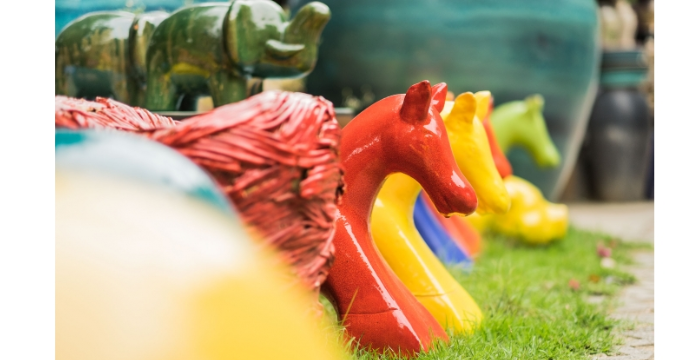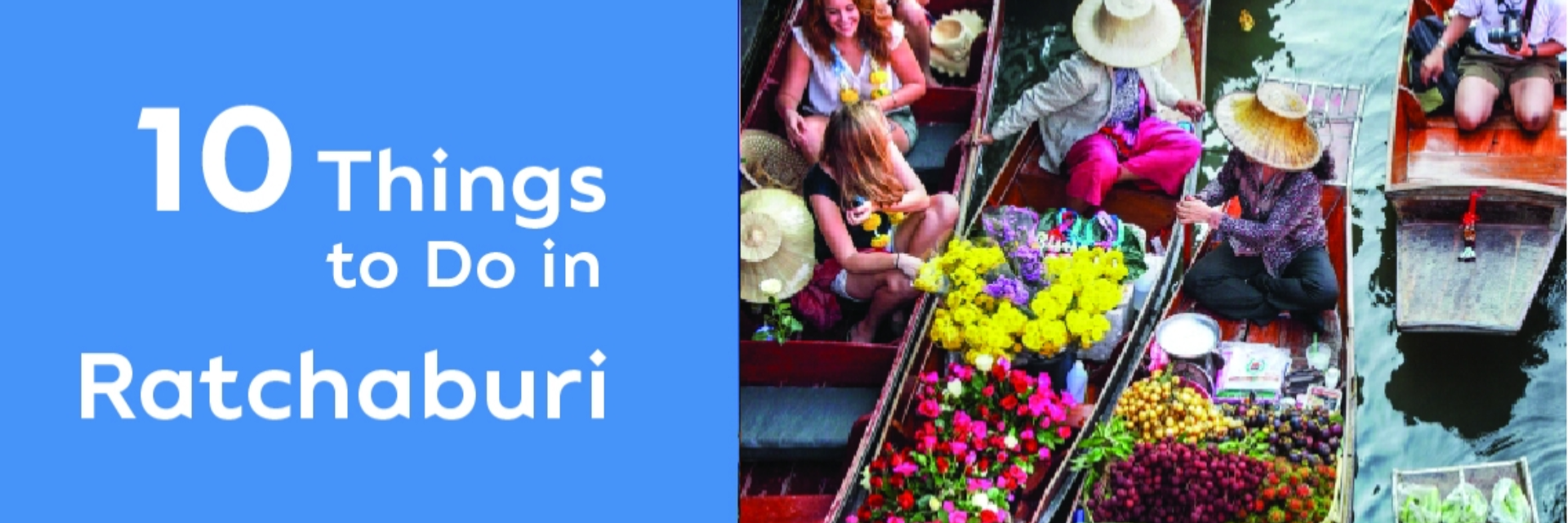DETAILS
1. Wat Mahathat Worawihan
Wat Mahathat Worawihan (วัดมหาธาตุวรวิหาร) or formerly called Wat Na Phrathat or Wat Phra Si Rattana Mahathat, was assumed to have been built in the Dvaravati period almost at the same time as that of old Ratchaburi town and built over by a Khmer or Lop Buri art sanctuary in about the 13th century to be a centre of the city, according to the belief of the Khmer’s cosmology. Later, the sanctuary probably collapsed and was replaced by a new prang in the early Ayutthaya period to be an overlapping architectural pattern as it appears today. The temple features some interesting objects; such as, Wihan Luang enshrining Phra Mongkhon Buri, a stucco Buddha image in the attitude of subduing Mara built with the art of the early Ayutthaya period with the Sukhothai period face, long body, short knees and face turning towards the East. Behind this is another Buddha image turning its back against each other called, Phra Si Nat, his face turning towards the West. This kind of Buddha image’s construction symbolises asking the Buddha images for protection from harm at the front and the back direction that is called Phra Raksa Mueang, according to the Ayutthaya people’s belief.
Prang: The 24-metre-high prang towers comprise the principal prang and satellite prangs situated on the South, West and North lying on the same base. On the East, there is a porch with steps meanwhile the Ruean That (important part of prang) base and the top are adorned with stucco designs. Inside the principal prang is a connecting chamber. On the upper part of the wall is the mural depicting the Buddha’s life in a row under the arched frame. The terrace base is encircled with a walkway, and the cloister around the prang’s terrace are installed many stone Buddha images in the Dvaravati, Lop Buri and Ayutthaya periods. In front of the prang is a building housing a stucco reclining Buddha image constructed in the Ayutthaya period as well as a museum displaying variety of jars.
Location: Khao Ngu Road, Tambon Na Mueang, Amphoe Mueang Ratchaburi, Ratchaburi province.
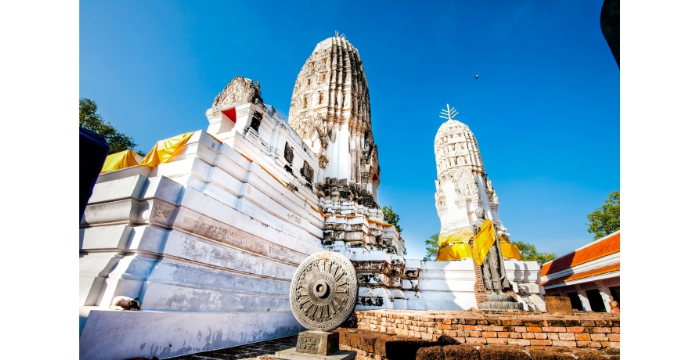

2. Khao Ngu Stone Park
Khao Ngu Stone Park (อุทยานหินเขางู) is a cave or religious site relating to Buddhism. Inside the cave were found many carved Buddha figures on the wall; for example, Phra Phuttha Chai at Tham Ruesi Khao Ngu sitting in an European style in the attitude of giving a sermon, according to the Dvaravati period (between the 6th to 8th centuries) features a flat face, curvy eyebrows connecting in the shape of parentheses, large curls with the radiance in the shape of a lotus bud, between his ankles are inscribed the Pallava script in Sanskrit language that can be transcribed into the phase Punyakam Chara Si Samathi Khupta, which means Phra Si Samathi Khupta is purified by merit making. This is one of the important art traces of the Dvaravati period. The cave also houses many sandstone Buddha images in the Ayutthaya period.
Interesting places around the Park include the 128 metre-tall Buddha’s Footprint made of laterite installed in the wihan on the top of Khao Ngu. It is a ruined rectangular building made of brick and cement. Tham Fa Tho, a cave located 250 metres to the west from Tham Ruesi Khao Ngu consists of carved pictures on the southern wall of a large reclining Buddha image with a group of deities and tree-shaped stuccos above. On the north is a carved picture of the Buddha’s two disciples, which reflects a feature like that of Tham Cham, a picture of the Buddha’s story when he attained nirvana. A festival is annually held to pay homage on the 1st day of the waxing moon of the 11th lunar month (October). On the Khao Ngu mountain range is situated Tham Rakhang and Khao Phra Bat with a Buddha’s Footprint on the mountaintop as well as a scenic point of Khao Ngu.
Location: Tambon Phlapphla, Amphoe Mueang Ratchaburi, Ratchaburi province.
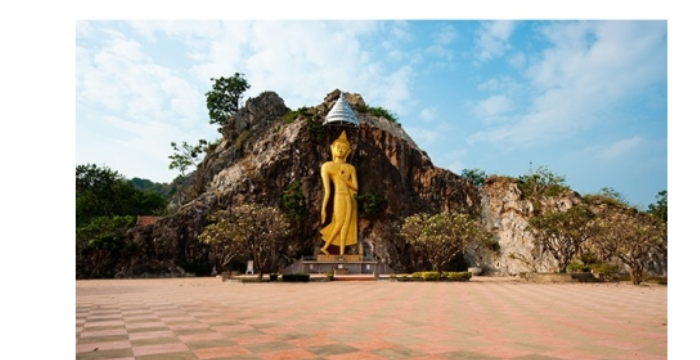

3. Wat Khanon Nang Yai
Wat Khanon Nang Yai (วัดขนอนหนังใหญ่). The Nang Yai Wat Khanon National Museum is located at Wat Khanon on the Mae Klong Riverside. The Museum’s building features a traditional Thai house showcasing an exhibition of the shadow puppet drama including the background and carving leather process. There are 313 shadow puppets; most of them are characters in the Ramayana literature, of which are divided into the following episodes: Hanuman Thawai Waen, Sahatsakuman and the Burning of Langka, and the first Indrajit Battle. The Museum is part of the Royally Initiated Project of HRH. Princess Maha Chakri Sirindhorn. Shadow Puppet Drama is appraised as a high-class play. The leather is elaborately carved and a traditional Thai grand orchestra is played along with the puppeteers’ skills accompanied by reciting and singing. Wat Khanon is the only temple that provides the entertaining performance of the shadow puppets show that has been carried on until today. In addition, it is considered to be the complete Nang Yai group under patronage of the temple.
The Museum is open daily between 8.00 a.m. – 5.00 p.m. A show performed by students from Wat Khanon School is performed every Saturday at 10.00 a.m. and every Sunday at 11.00 a.m. once a day. Free admission.
Location: Wat Khanon, Tambon Soi Fa, Amphoe Photharam, Ratchaburi province.
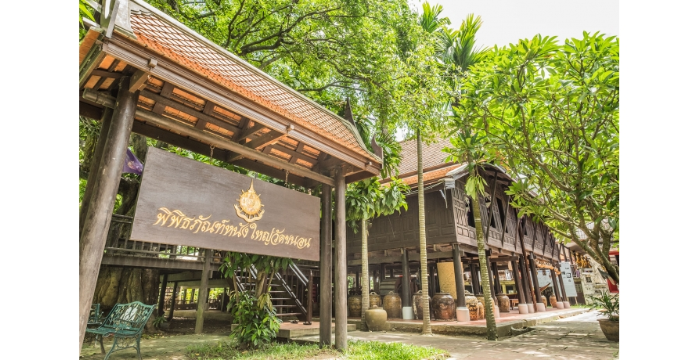

4. Wat Pho Rattanaram or Wat Pho Khu
Wat Pho Rattanaram or Wat Pho Khu (วัดโพธิ์รัตนาราม หรือวัดโพธิ์คู่). The highlight of this temple is Thailand’s second stainless steel ubosot (ordination hall), (the first stainless ubosot is at Wat Pa Lam Kha Khaeng, Kanchanburi province). The restoration was made by using stainless steel to cover a former cement-built ubosot. The other significant object is the Buddha image in an attitude of accepting offerings from an elephant and a monkey in a sitting manner with his feet placed on a lotus, both hands overturned and placed on his knees. One side of the Buddha image is a figure of a crouching elephant with his trunk holding a bamboo tube with water inside and a monkey offering a honeycomb on the other side. The story of this gesture came from the legend in the Buddha’s time; there were disputes among monks and they had difficult behavior, so the Buddha then went for a retreat in the village of Pali Loei Yaka. He was taken care of by a great elephant and a monkey that gave him a honeycomb as an offering, but he rejected it because the embryos were still inside. The construction of the Buddha image in this gesture implies the Dharma puzzle of a dispute that breaks the unity.
Location: Mu 5, Tambon Pak Rat, Amphoe Ban Pong, Ratchaburi province.

5. Khao Kra Chom
Khao Kra Chom (เขากระโจม) in Amphoe Suan Phueng is one of the districts located at the westernmost border of the country that has cool weather like in the North. Thus, this district has become one of the most popular destinations among tourists. Khao Kra Chom is situated near the operation base of the Border Patrol Police. With the height of 1,000 metres above mean sea level, visitors can admire the atmosphere of the sea of mist in the morning that is similar to the mountaintop’s atmosphere in the North. It is recommended to arrive at dawn during 5 – 6 a.m. to wait for the sea of mist and sunrise. Along the path is an abundant forest and on the way back, visitors can stop by to view Namtok Pha Daeng, where the rare orchid species is found.
Location: Tambon Suan Phueng, Amphoe Suan Phueng, Ratchaburi province.
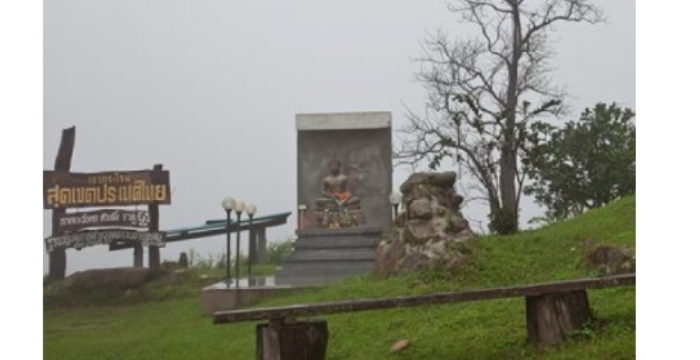

6. Namtok Kao Chan “Kao Chon”
Namtok Kao Chan “Kao Chon” (น้ำตกเก้าชั้น “เก้าโจน”) is located 1 kilometre from Bo Khlueng Hot Stream. The 9-tiered waterfall runs down from the high cliff in the mid valley with water all year-round. The quantity of water increases in the upper tiers. The waterfall area is granite rock.
To get there: From the parking spot, walk on foot for about 500 metres to reach the waterfall’s lower level, and it is accessible on foot to the last level. It takes about 2 – 3 hours for a 2–kilometre walking distance. The first tier is 500 metres from the parking lot; the fourth tier is quite slippery and not good for swimming; the sixth tier is usually full of beautiful water flowing down the rock cliff in the rainy season. From the sixth to ninth tiers, the route is sloping and at least 2 persons should go together for helping each other in climbing. To get to the top level, tourists must depart before noon and return before 4 p.m.
Location: Mu 7, Ban Huai Phak, Tambon Pha Phueng, Amphoe Suan Phueng, Ratchaburi province.
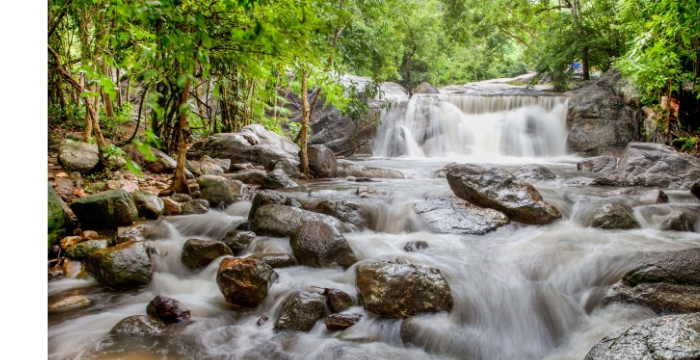

7. Bo Khlueng Hot Stream
Bo Khlueng Hot Stream (ธารน้ำร้อนบ่อคลึง), originating from the Thanao Si Mountain Range, is hot water with a temperature between 49–58 degrees Celsius. During winter in the morning, the hot steam will float and form a stunning fog. The site provides 3 types of mineral ponds: soil pond where the hot stream flows down in a natural environment of plant species, a ceramic pool for bathing in natural hot water, and a feet dipping pond that is a rectangular pond with edges for sitting and dipping feet. The bathing service charge for a natural hot pond: 50 Baht for adults and 30 Baht for children; for the ceramic pool: 80 Baht for adults and 50 Baht for children. Open from Monday to Friday during 8.00 a.m. – 5.00 p.m.; Saturday and Sunday during 8.00 a.m. – 6.00 p.m. The entrance fee is 5 Baht. For more information, please call Tel. 0 3232 9025, 08 9918 2114.
In addition, visitors can take a stroll to see the head spring with natural surroundings. Walking for about 150 metres, you can see a hot mineral stream with rocks lying underneath. With the cool weather in the morning, the hot steam will float up into beautiful flows. This spot is popular for taking pictures. Dipping feet in the water is not allowed since it is the head spring that local people use for consumption.
Location: Mu 7, Ban Huai Phak, Tambon Suan Phueng, Amphoe Suan Phueng, Ratchaburi province.


8. Damnoen Saduak Floating Market – Lao Tak Lak – Lak Ha
Damnoen Saduak Floating Market – Lao Tak Lak – Lak Ha (ตลาดน้ำดำเนินสะดวก-เหล่าตั๊กลัก-หลักห้า). The Damnoen Saduak Floating Market in Amphoe Damnoen Saduak, Ratchaburi, is a true community’s life floating market. The scene of a canal crowded with boats paddled by vendors selling farming produce, food and desserts from the community as a daily routine has drawn tourists and is world-renowned. It is one of the must-see places for tourists.
The floating market offers a community’s life tour by paddle boat to observe the orchards and making of syrup from the palm’s sap, which takes about 1 hour at 400 Baht per boat as well as a trip to see the way of life along Khlong Damnoen Saduak for an hour by a long-tailed boat. A suitable time to see the market and buy products is during 7.00 a.m. until noon.
The old Damnoen Saduak Floating Market (Khlong Lat Phli) or Lao Tak Lak-Lak Ha Market is located at Wat Rat Charoen Tham (Wat Sun). The word “Lao Tak Lak” means an old market. It is the old Damnoen Saduak Floating Market that has been restored to be lively as it used to be. The Market offers chemical-free vegetables and fruit, Kuai Tiao Ruea (Thai-style noodles) and old-styled coffee by vendors selling on boats and on a walkway along the river amidst the atmosphere of old-styled wooden houses in rows, which include original shops providing various food and utensils. It is recommended to stop by at an old coffee shop to try while observing the local life by the canal. The Market also includes a boat tour to sightsee the Floating Market’s way of life, traditional massage, health treatment with a herbal compress and a herbal sauna, and OTOP products.
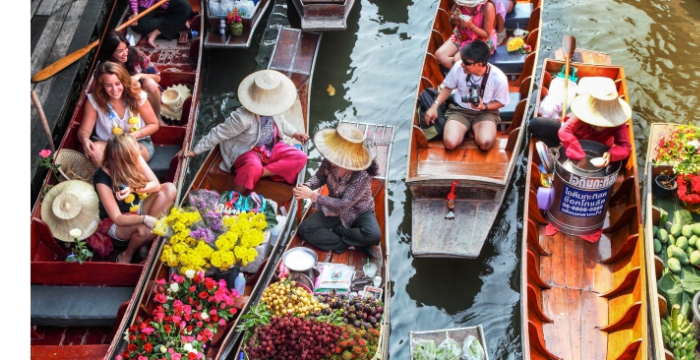

9. The Blooms Orchid Park
The Blooms Orchid Park (อุทยานกล้วยไม้เดอะบลูมส์) is an orchid park in a natural environment for viewing plant species including colourful orchids of pure and mixed breeds alternating with perennial plant gardens and a little cascade. Plantations, hygienic vegetable garden, and herbal plants are also available. Various orchid species are for sale. Open on Monday to Friday during 9.00 a.m. – 5.00 p.m. and Saturday – Sunday and special holidays during 8.30 a.m. – 5.30 p.m. Admission fee: 80 Baht for adults and 40 Baht for children (less than 110 cm. in height). For more details, please call Tel. 08 1942 2608. Location: 666, Mu 7, Tambon Wang Kaeo, Amphoe Bang Phae, Ratchaburi province.
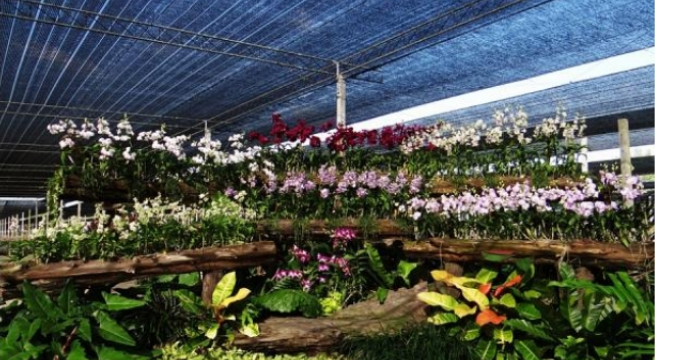

10. Dragon Jar Ratchaburi
Dragon Jar Ratchaburi (โอ่งมังกรราชบุรี), situated at Rattanakosin 1 on Phetchakasem Road Km. 98 heading to the South, is a famous terracotta jar factory of Ratchaburi province, and a five-star OTOP awarded recipient. The factory produces numerous pieces of sculpture from small to large pieces for both wholesale and retail. The products are suitable for souvenirs and functional work. To produce terracotta, they use firewood as a fuel that is an original local wisdom method. It is recommended to stop by for taking a picture with the dragon jar, Ratchaburi province’s symbol. Open daily during 8.00 a.m. – 5.00 p.m. For more information, please call Tel. 0 3231 6767, 0 3232 1322, 0 3231 6788, 0 3232 1323.
Tao Hong Tai Ceramics Factory situated on Phetchakasem Road Km. 101 heading to the South, has transformed from a jar-moulding factory to a well-known ceramics factory of Ratchaburi. The Factory has modernised old style ceramic sculpture in terms of shapes, drawing, and the use of more than 600 shades of colours to become unique artworks. For more information, please call Tel. 0 3232 7574, 0 3232 3630.
Tao Hong Tai: d Kunst Contemporary Art Gallery is located at 323, Woradej Road, Tambon Na Mueang, Amphoe Mueang Ratchaburi, Ratchaburi province close to the Ratchaburi National Museum at the Mae Klong Riverfront. It was believed that the building was constructed at the end of the reign of King Rama V the Great. It features a gingerbread style wooden house built on stilts and was renovated in 2005. The 3-storey building received the Outstanding Architectural Conservation Award in 2011. The name “D Kunst” comes from the German language meaning art. The building decorated with ceramics from the Tao Hong Tai Factory is open as a gallery for artworks and a bakery and coffee shop selling souvenirs as well. The rotation contemporary art exhibition is held every three months. Open during 11.00 a.m. – 8.00 p.m. For more information, please call Tel. 0 3232 3630, 0 3233 7574.
